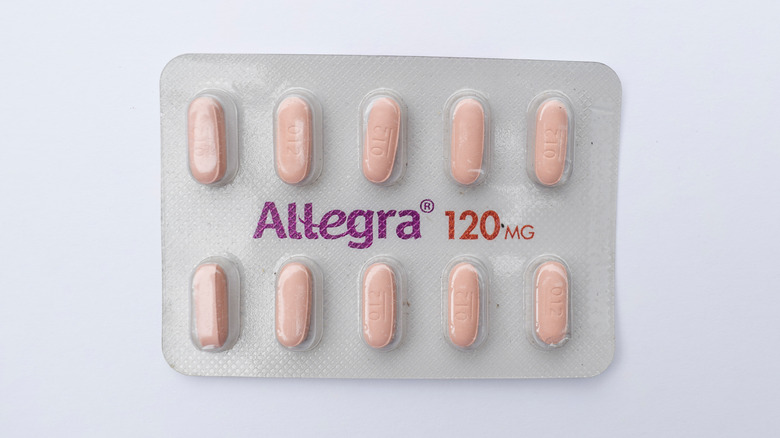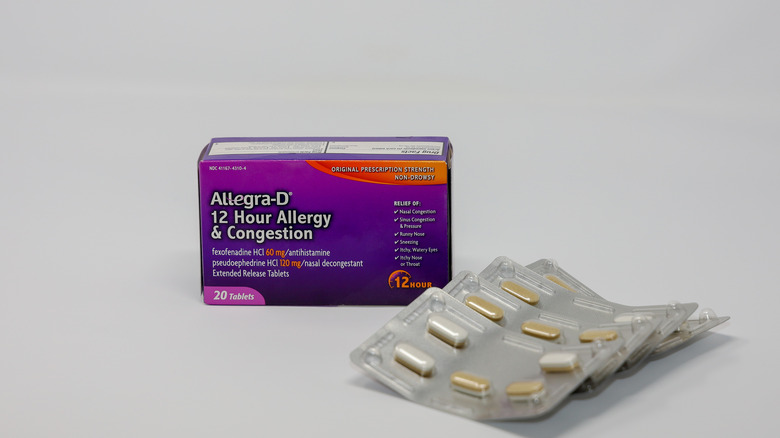Allegra Explained: Usage, Dosage, And Side Effects
Ah, allergy season, where our red and itchy eyes water uncontrollably and our noses run constantly. While allergies are never any fun to deal with, according to the Centers for Disease Control and Prevention (CDC), there are more than 60 million people in the U.S. alone that suffer from them each year. Luckily, antihistamines like Allegra can prove to be the perfect cure for unwanted allergies (per Harvard Health Publishing), fighting off allergy symptoms before they arrive.
Allegra has become a popular medication choice among allergy sufferers who are attempting to prevent allergy symptoms from taking over their lives. The medicine has been proved over time as a top over-the-counter allergy medication that helps bring relief in less than two hours (via GoodRx). However, like any medication, Allegra has its own host of side effects and level of effectiveness. Lucky for you, we're here to answer all your questions about Allegra so that you can decide if it is the right allergy relief medicine for you.
What is Allegra?
In 1985, Raymond Woosley discovered fexofenadine. The discovery came after he and a team of scientific researchers were investigating an allergy medication called Seldane that was causing numerous health issues, per Association of University Technology Managers. During his research, he found that fexofenadine was the secret ingredient in Seldane that targeted allergies without causing unwanted side effects. This led Woosley to use fexofenadine as the key ingredient in Allegra, a rising allergy relief medication that became FDA-approved in 1996.
Allegra's preventative nature was a big reason behind why it grew so quickly in popularity. In order to understand how the medicine works, imagine that you come into contact with an allergen like pollen. If your body perceives the pollen as a harmful invader that it needs to attack, its response is to release a natural chemical called histamine, which produces the unwanted side effects of allergies like sneezing or watery eyes, per GoodRx Health. Now, allegra falls under the class of drugs known as antihistamines, along with other common medications such as Claritin (loratadine) and Zyrtec (cetirizine). These kinds of drugs work by minimizing the side effects caused by histamine in the body — or, if the antihistamine is taken in advance of exposure to allergens, they can even prevent the side effects from occurring altogether. For this reason, Allegra became a common medication choice to treat symptoms of seasonal allergies (via Drugs.com).
Allegra is a second-generation antihistamine, per WebMD. These antihistamines have the same allergy-preventing benefits as the original antihistamines such as Benadryl (diphenhydramine), but without the drowsiness that first-generation medications often cause. This lets users enjoy Allegra as a non-drowsy relief option.
When to use Allegra
With spring around the corner, we have warm summer days to look forward to. However, spring is also the start of hay fever season when pollen count drastically increases and induces allergies in many, per the National Health Service. If you know that your allergies are heightened during a particular season, then it may be best to start Allegra prior to that time period, especially if you will be exposed to your allergy triggers (via Allergy & Asthma Network). Of course, Allegra can also be taken after your allergies are triggered in order to prevent symptoms from further escalating.
For adults and children over the age of 12, Allegra can be taken to get relief from hay fever and allergy-like symptoms such as a runny nose, itching, and watery eyes (per Allegra.com). Just be sure to consult your doctor before starting Allegra and take the medication as directed, according to Drugs.com.
How much Allegra should you take?
Since Allegra comes in a few different forms, its dosage depends on the form and strength that you opt to take. For instance, Allegra is available in pill form that can be swallowed, disintegrating tablets that dissolve in your mouth, and a liquid form that can be swallowed (per the Mayo Clinic). The pill is typically directed to be consumed every 12 hours or twice daily, unless you take the 24-hour Allegra relief pill of 180 mg, which needs to be consumed only once a day.
The Allegra dissolving tablets can be easily dissolved on the tongue with or without water. For the Allegra drops, you can opt to take 10 mL every 12 hours for adults and children over the age of 12 (per Allegra.com). In order to get optimal results from the form of Allegra that you choose to take, it is best to closely follow the directions in terms of dosage.
According to Patient, it is best to consume Allegra on an empty stomach and at the same time each day. In addition, it is also fine to discontinue Allegra once your symptoms have eased, unless directed otherwise by your doctor.
Effectiveness of Allegra
With a host of antihistamines available on the market, it can be difficult to choose the right fit for you. However, what sets Allegra apart is its effectiveness. Allegra not only starts working within an hour or two but also, has effects that can last for up to 24 hours per day. "I personally really like Allegra, as it's effective, stronger than Claritin and shouldn't make anyone drowsy," said board-certified allergist Ratika Gupta in an interview with Forbes Health. Because of Allegra's non-drowsy nature, it is easy for allergy-sufferers to gravitate toward it for substantial relief without the added pain of tiredness that many allergy medications can cause.
The good news about Allegra is that it is very well-tolerated amongst patients. In fact, a small study published in the Clinical & Experimental Allergy journal showed that even at a high dose of 360 mg, which is double the daily recommended dose, the medicine had no effects on psychomotor and cognitive function. This sets the Allegra apart from other antihistamines like promethazine, which can impair cognitive and psychomotor functions at higher doses.
Allegra versus Allegra-D
A quick trip to the nearest pharmacy will show you that there are both Allegra and Allegra-D available for purchase. So, which one should you choose? For starters, it's important to note that the D in Allegra-D stands for "decongestant." This essentially means that Allegra-D combines both the active ingredients fexofenadine and pseudoephedrine to relieve congestion in addition to traditional allergy symptoms that Allegra normally battles (per GoodRx).
Allegra-D is a good choice to opt for if you are experiencing nasal congestion, sinus pressure, or a stuffy nose and would prefer to take a single pill to solve all of your allergy issues rather than taking cold medication in addition to Allegra, via RxList. Thankfully, Allegra and Allegra-D both have the same effectiveness and take a similar amount of time to produce relief. Allegra-D is also available in 12- and 24-hour pill options, but will cost a little more per package than a comparable amount of regular Allegra (per SingleCare).
Allegra for children
Allegra is typically intended for ages 12 and up. However, there is Allegra available for children under the age of 12 in liquid form. According to WebMD, Children's Allegra can be used to treat allergies, hives, and itching in children between the ages of 2 to 12 years. In fact, Children's Allegra is quite popular and rated as the most recommended children's non-drowsy allergy brand (per Allegra.com).
There are plenty of plus points of Allegra geared towards children, including its non-drowsy nature and liquid form that makes the medication easy to swallow. Each liquid bottle also comes with a special measuring device or spoon that helps you take the correct dosage of the medication. Moreover, the effects are said to last around 12 hours. However, it's important to note that Children's Allegra is not intended for children younger than 2 years old, via Drugs.com. Disintegrating Allegra tablets are also available for children 6 years and older.
Possible side effects of Allegra
Unfortunately, side effects are always a possibility with medication. With Allegra being a second-generation antihistamine, the side effects are greatly reduced in comparison to first-generation antihistamines. However, there is still a possibility that some users may experience mild symptoms like headache, tiredness, vomiting, and nervousness, according to MedicineNet. According to Fexofenadine, the most common side effects of Allegra include fatigue and drowsiness, along with dry mouth. However, it is important to note that while allergy medications are known to be traditionally accompanied by sleepiness, Allegra is the least sedating drug amongst its class of second-generation antihistamines, which also include Benadryl, Zyrtec, and Claritin (per Allergy & Asthma Network).
Of course, it is important to look out for more serious possible side effects such as rashes, swelling of the face or body, trouble breathing, chest tightness, and fast heartbeat, via SingleCare. Seek help immediately if you notice any of these symptoms. Luckily, severe reactions to Allegra are rare. In addition, it is also worth noting that regular antihistamine use has been linked to higher insulin concentrations and a tendency to be overweight (per UC San Diego Health).
Some people should not take Allegra
As with all medications, Allegra is not well-suited for everyone. Though the medication is generally well-tolerated, if you suffer from certain health problems like kidney disease, heart disease, high blood pressure, diabetes, or an overactive thyroid gland, then it may be best to consult your doctor before using Allegra, per WebMD. It is also best to avoid Allegra or any allergy medication if you are in the first trimester of pregnancy (via Sanford Health).
Since studies have yet to be performed on the effects of fexofenadine, the main ingredient in Allegra, on children below the age of six months, it is advised not to give this medication to young children, according to the Mayo Clinic. In addition, if you are waiting to have an allergy test, it is advisable not to consume Allegra for a few days, according to the National Health Service, as it can impact your test results.
Interactions with other medications
If you plan on taking Allegra, it may be best to revisit your medication list first. This is in order to ensure that there are no drug interactions taking place. Allegra loses much of its effects when mixed with antacids that contain aluminum or magnesium (per Healthgrades). For this reason, it is best to avoid taking an antacid at least half an hour before or after taking an Allegra.
While it is typically safe to use different allergy medications simultaneously if they're in different drug families, keep in mind that this will also increase the amount of side effects that you experience, notes GoodRx Health. Additionally, if you opt to take Allegra-D, then it is best to avoid using a nasal spray or additional decongestant, since Allegra-D already contains a decongestant.
There are over 91 drugs that are known to react with Allegra (per Drugs.com). Luckily, none of these reactions are severe. Yet, it is advisable to review your current medication list to see if any interactions might exist. According to the University of Rochester Medicine, it may also be best to consult your doctor before starting any new medications or supplements.
Interactions with food and drink
Your medications aren't the only thing that you need to be aware of when taking Allegra. Turns out, certain fruit juices like orange, apple, and grapefruit can also decrease Allegra's effects and moderately interact with the medication (via HealthCentral). In fact, grapefruit is one specific fruit juice that has a reputation for interacting with many different types of medications due to causing metabolization or absorption issues. Unfortunately, in the case of Allegra, both grapefruit and a handful of other fruit juices can block the enzymes and transporters in your body from absorbing the right amount of the drug. This can also increase the nature of side effects (per the U.S. Food & Drug Administration).
In order to avoid unnecessary side effects and get the most out of your antihistamine, it may be best to hold off on consuming fruit juices shortly before or after taking an Allegra. It may also be advisable to avoid alcohol while taking allergy medications, per SingleCare. However, since Allegra is a second-generation antihistamine, the chances of intense side effects like drowsiness after consuming alcohol are reduced.
Allegra versus other antihistamines
With a variety of antihistamines on the market, it may be hard to find one that is the right fit for you. The good news is that antihistamines generally all serve the same purpose of keeping your allergies at bay. The question then comes down to what side effects are you willing to tolerate? Generally, with second-generation antihistamines such as Allegra, Claritin, and Zyrtec, side effects and drug interactions will be more minimal than with first-generation antihistamines like Benadryl, which contains the drowsy ingredient diphenhydramine (per Curist).
The second generation of antihistamines is also known to be more effective. The active ingredients in these drugs are what separate them from one another. For instance, fexofenadine is the primary ingredient in Allegra, while loratadine is the main ingredient for Claritin, and cetirizine is the underlying ingredient behind Zyrtec, per Healthline. Other differences include onset time, which is only an hour for Zyrtec, and between two to three for Claritin and Allegra. Zyrtec also costs a few dollars less out of the three, retailing at about $4 for a generic 30-day supply with a GoodRx coupon (per GoodRx Health). However, it also has been known to cause more tiredness than Claritin or Allegra.
Overall, since these drugs work very similarly to relieve runny nose, watery eyes, and other symptoms of allergies, the difference comes down to the drug that you personally find more relief on.












